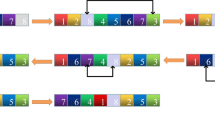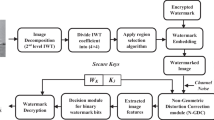Abstract
Steganography is one of the most important approaches for secure transmission by concealing secret data into a host image imperceptibly. To achieve a good tradeoff between the hiding capacity and image quality, more work needs to be further researched. In this paper, to obtain satisfactory results, a Bi-Stretch Hiding (BSH) algorithm for absolute moment block truncation coding (AMBTC)-compressed image is proposed. In the scheme, the AMBTC-compressed image is divided into non-overlapped blocks first, after that, four feasible cases are employed to embed secret data, which takes advantage of the characteristics of the coefficients of the AMBTC-compressed image and lead tiny distortion of the AMBTC-compressed image. The experimental results demonstrate that the proposed BSH scheme outperforms the other state-of-the-art compression data hiding methods.











Similar content being viewed by others
References
Alattar AM (2004) Reversible watermark using the difference expansion of a generalized integer transform. IEEE Trans Image Process 13(8):1147–1156
Bhatbagar G, Wu QMJ, Atrey PK (2013) Secure randomized image watermarking based on singular value decomposition. ACM Trans Multimed Comput Commun Appl (TOMM) 10(1) doi: 10.1145/2542205.2542207
Chan YK, Chen WT, Yu SS, Ho YA, Tsai CS, Chu YP (2009) A HDWT-based reversible data hiding method. J Syst Softw 82(3):411–421
Chang CC, Lin CC, Tseng CS, Tai WL (2007) Reversible hiding in DCT-based compressed images. Inf Sci 177(13):2768–2786
Delp EJ, Mitchell OR (1979) Image compression using block truncation coding. IEEE Trans Commun 27(9):1335–1342
Golle P, McSherry F, Mironov I (2008) Data collection with self-enforcing privacy. ACM Trans Inf Syst Secur (TISSEC) 12(2). doi: 10.1145/1455518.1455521
Guo JM, Liu YF (2012) High capacity data hiding for error-diffused block truncation coding. IEEE Trans Image Process 21(12):4808–4818
Guo JM, Tsai JJ (2012) Reversible data hiding in low complexity and high quality compression scheme. Digital Signal Process 22(5):776–785
Hu Y, Lee HK, Li J (2009) DE-based reversible data hiding with improved overflow location map. IEEE Trans Circuits Syst Video Technol 19(2):250–260
Lee JD, Chiou YH, Guo JM (2010) Reversible data hiding based on histogram modification of SMVQ indices. IEEE Trans Inf Forensics Secur 5(4):638–648
Lema MD, Mitchell OR (1984) Absolute moment block truncation coding and its application to color images. IEEE Trans Commun 32(10):1148–1157
Li X, Yang B, Zeng T (2011) Efficient reversible watermarking based on adaptive prediction-error expansion and pixel selection. IEEE Trans on Image Process 20(12):3524–3533
Lin PY, Lee JS, Chang CC (2011) Protecting the content integrity of digital imagery with fidelity preservation. ACM Trans Multimed Comput Commun Appl (TOMM) 7(3). doi: 10.1145/2568224
Lin CC, Liu XL, Tai WL, Yuan SM (2013) A novel reversible data hiding scheme based on AMBTC compression technique. Multimed Tools Appl. doi:10.1007/s11042-013-1801-5
Mielikainen J (2006) LSB matching revisited. IEEE Signal Process Lett 13(5):285–287
Ni Z, Shi YQ, Ansari N, Su W (2006) Reversible data hiding. IEEE Trans Circuits Syst Video Technol 16(3):354–362
Ou DH, Sun W (2014) High payload image steganography with minimum distortion based on absolute moment block truncation coding. Multimed Tools Appl. doi:10.1007/s11042-014-2059-2
Sun HM, Weng CY, Wang SJ, Yang CH (2013) Data embedding in image-media using weight-function on modulo operations, ACM Trans Embedded Comput Syst (TECS) 12(2). doi: 10.1145/2423636.2423639
Tai WL, Yeh CM, Chang CC (2009) Reversible data hiding based on histogram modification of pixel differences,”. IEEE Trans Circuits Syst Video Technol 19(6):906–910
Thodi DM, Rodriguez JJ (2007) Expansion embedding techniques for reversible watermarking. IEEE Trans Image Process 16(3):721–730
Tian J (2003) Reversible data embedding using a difference expansion. IEEE Trans Circuits Syst Video Technol 13(8):890–896
Tsai P (2009) Histogram-based reversible data hiding for vector quantisation-compressed images. IET Image Process 3(2):100–114
Tseng HW, Hsieh CP (2009) Prediction-based reversible data hiding. Inf Sci 179(14):2460–2469
Wang X, Golle P, Jakobsson M, Tsow A (2010) Deterring voluntary trace disclosure in re-encryption mix networks. ACM Trans Inf Syst Secur (TISSEC) 13(2). doi: 10.1145/1698750.1698758
Xuan G, Zhu J, Chen J, Shi Y, Ni Z, Su W (2002) Distortionless data hiding based on integer wavelet transform. Electron Lett 38(25):1646–1648
Yang HC, Tsai HM (2010) Improving histogram-based reversible data hiding by interleaving predictions. IET Image Process 4(4):223–234
Author information
Authors and Affiliations
Corresponding author
Rights and permissions
About this article
Cite this article
Li, F., Bharanitharan, K., Chang, CC. et al. Bi-stretch reversible data hiding algorithm for absolute moment block truncation coding compressed images. Multimed Tools Appl 75, 16153–16171 (2016). https://doi.org/10.1007/s11042-015-2924-7
Received:
Revised:
Accepted:
Published:
Issue Date:
DOI: https://doi.org/10.1007/s11042-015-2924-7




